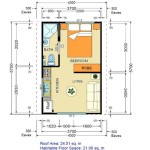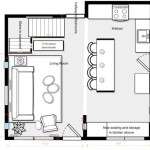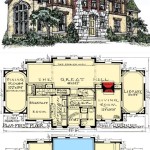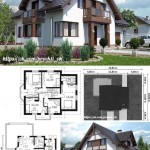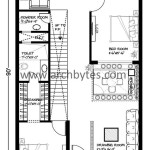Example Set of House Plans: A Comprehensive Guide
Finding the perfect house plan is a crucial first step in the home-building process. A well-designed plan provides a roadmap for construction, outlining room layouts, dimensions, and structural details. This article presents an example set of house plans, highlighting key features and considerations to help illustrate the components of a typical plan.
Key Features of the Example House Plan
This example showcases a two-story, single-family home designed for a modern lifestyle. The plan incorporates open-concept living spaces, ample natural light, and a focus on functionality. The overall square footage is approximately 2,500 square feet, excluding the garage.
First Floor Layout
The first floor prioritizes shared living spaces. Upon entering, a spacious foyer leads to the main living area, which seamlessly integrates the living room, dining area, and kitchen. This open-concept design promotes interaction and creates a sense of spaciousness. A dedicated home office space is also located on the first floor, catering to the increasing demand for work-from-home environments.
Adjacent to the kitchen, a mudroom provides a practical space for storage and organization, keeping clutter away from the main living areas. A half-bathroom is conveniently located near the mudroom and the main entrance for guests.
Second Floor Layout
The second floor is dedicated to private spaces. The master suite is strategically positioned away from the other bedrooms for increased privacy. It features a generously sized bedroom, a walk-in closet, and an en-suite bathroom. Three additional bedrooms share a well-appointed full bathroom. A conveniently located laundry room on the second floor simplifies household chores.
Exterior Features
The exterior of the house features a combination of siding and stone accents, creating a visually appealing and durable facade. A covered front porch provides a welcoming entry point, while a rear patio extends the living space outdoors. A two-car garage offers ample parking space and additional storage options.
Plan Considerations: Customization and Adaptation
This example plan serves as a starting point. It can be customized to meet individual needs and preferences. Modifications to room sizes, layout configurations, and exterior finishes can be easily incorporated. Consulting with an architect or builder is essential to ensure any modifications adhere to building codes and structural requirements.
Plan Considerations: Site Analysis and Orientation
Before finalizing any house plan, conducting a thorough site analysis is crucial. Factors such as topography, soil conditions, and sun orientation should be carefully considered. Optimizing the house's orientation can maximize natural light and minimize energy consumption.
Plan Considerations: Budget and Material Selection
Building a home involves significant financial investment. Establishing a realistic budget early in the planning process helps guide material selection and ensures the project remains within financial constraints. Exploring different material options and comparing costs can significantly impact the overall budget.
Blueprint Details and Specifications
A complete set of house plans includes detailed blueprints and specifications. These documents provide precise measurements, structural details, and material specifications required for construction. The blueprints typically include floor plans, elevations, sections, and foundation plans. The specifications outline the required materials, finishes, and construction methods.
Working with Professionals
Navigating the intricacies of house plans and construction requires expertise. Engaging qualified professionals, such as architects, builders, and engineers, is essential throughout the process. These professionals can offer valuable guidance, ensure adherence to building codes, and manage the construction process effectively.
Understanding Plan Symbols and Notations
House plans utilize specific symbols and notations to represent various elements, such as walls, doors, windows, and plumbing fixtures. Familiarizing oneself with these symbols is essential for interpreting the plans accurately. Online resources and architectural guides provide comprehensive explanations of common plan symbols.
Importance of Scaled Drawings
House plans are drawn to scale, allowing for accurate representation of dimensions and proportions. Understanding the scale used is crucial for interpreting the drawings correctly and visualizing the actual size of the spaces. Scaled drawings ensure accurate construction and prevent costly errors.
Accessibility and Universal Design Principles
Incorporating accessibility features into the house plan can enhance usability and create a more inclusive environment. Universal design principles aim to create spaces that are accessible and functional for people of all ages and abilities. Features like wider doorways, zero-step entries, and adaptable bathroom fixtures can significantly improve accessibility.

What Is Included In A Set Of Working Drawings Best Ing House Plans By Mark Stewart Home Design

Building Plans Examples Inhouseplans Com

House Plans The Best And Barndominium Designs 2024

Floor Plans Learn How To Design And Plan

Sample Plan Quickplans

House Plans Under 100 Square Meters 30 Useful Examples Archdaily

12 Examples Of Floor Plans With Dimensions

House Plans How To Design Your Home Plan

How To Read House Plans Elevations

Draw Floor Plans In Half The Time Cedreo

